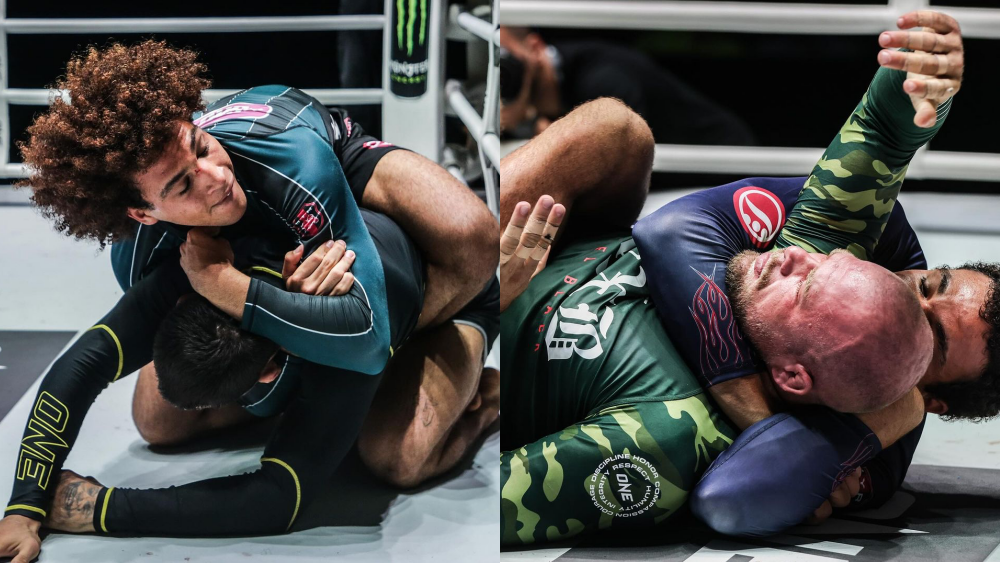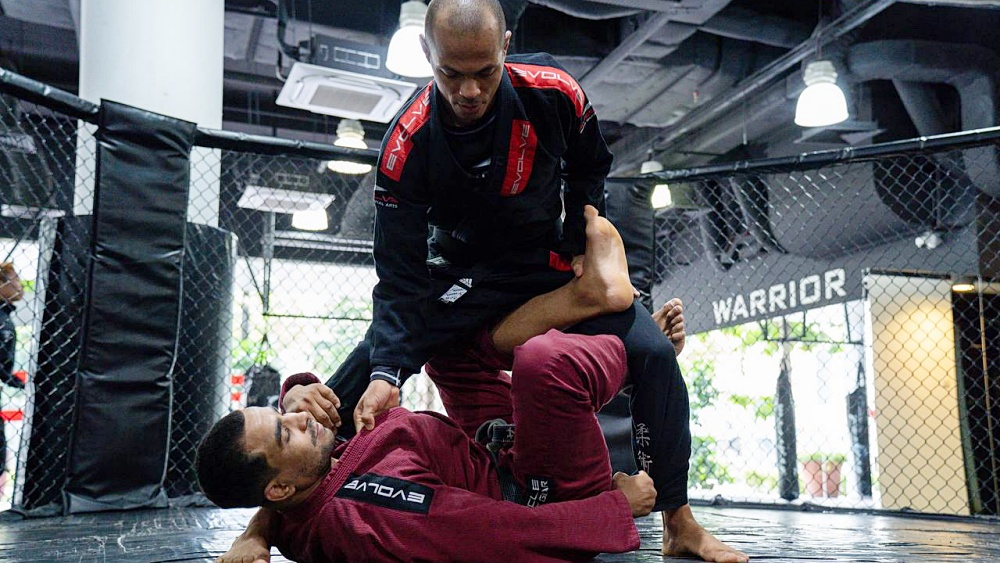In grappling sports like Brazilian Jiu-Jitsu and No-Gi submission grappling, chokes stand out as the most efficient way to put opponents out of action. Unlike joint locks, chokes are rarely endured, swiftly rendering opponents unconscious. In the current submission grappling meta, dominated by leg locks and wrestling, the Ruotolo brothers, Kade and Tye, are renowned for their mastery of various arm triangle attacks, offering a unique perspective.
With Tye and Kade reigning as the current ONE Lightweight and Welterweight Submission Grappling World Champions, respectively, let’s delve into their most recent submission victories, employing the same technique to defend their titles at ONE Fight Night 21. This article serves as an introduction to a submission named after the Ruotolo brothers, known as the Ruotolotine.
What Is The Ruotolotine?
The Ruotolotine presents a variation of a modified head and arm choke. Essentially, this submission employs the opponent’s shoulder to block their near carotid artery, while your forearm or wrist obstructs the other, disrupting blood flow. Distinguishable from the arm triangle, the Ruotolotine culminates on the back from the chair sit position, with hands locked akin to the D’Arce, contrasting with the arm triangle’s conventional execution from the side, typically from the mount.
Relatively, the Ruotolotine becomes an option once you have access to the opponent’s back while trapping them from the arm triangle on the side. It involves a head and arm choke executed from behind, utilizing your underhooking arm as the choking arm to grasp your other arm’s bicep. The opposite hand locks in the choke and reaches behind the opponent’s trapped shoulder or pushes their head down.
At its core, this submission is a variant of the head and arm choke family, as it uses the head and arm to limit movement and force the opponent to tap. The attacker uses the opponent’s own arm as a tool to limit the flow of blood, thereby forcing the opponent to either submit or pass out. As mentioned above, the head and arm (or triangle choke) family consists of popular submissions like the arm triangle choke, anaconda choke and D’Arce choke.
Understanding The Chair Sit
To execute the Ruotolotine effectively, it is essential to know the various methods of gaining access to the opponent’s back. Tye Ruotolo’s setup in his recent match involved initially securing the mount position, compelling the opponent to turn to one side. Subsequently, he capitalized on the position by transitioning to the chair sit, seizing the opponent’s back as he applied the choke.
The chair sit is a fundamental move in BJJ where you first get a chest-to-back connection to control the opponent’s torso, then use a sitting motion to transition to the back take. The central premise of the chair sit involves going from one side of your hip to the other while you shift your body weight at an angle. Doing this gives you the ability to secure your hooks, thus locking your opponent in place. Once you secure the back, your next course of action should be to attack the neck using submissions like the RNC, short choke, and Ruotolotine.
Ruotolotine Technique Breakdown
While both Ruotolo brothers concluded their recent matches using the Ruotolotine, let’s analyze Tye’s entry as he applies the choke from the back. Tye’s match with esteemed opponent Izaak Michell was characterized by intense scrambling, both standing and on the ground. For those unaware, Izaak Michell is a grappling phenom hailing from Australia. He won gold in the 2021 IBJJF World Championship as a brown belt, and has been coached by great minds of the art like John Danaher and Craig Jones. From the standup, Izaak executed an elbow drag, utilizing it to initiate a single leg takedown and transition to a rear body lock for back control.
Tye initiated a wrestling switch as he fell to the ground and attempted to insert his arm between Izaak’s legs to defend. Being exceptional with scrambles, Tye managed to sweep Izaak with a hip bump sweep by controlling the elbow and turning his entire body with his head facing sideways to accomplish the sweep. This was one of the highlights of the match, as the sweep was very unexpected and quick. And performing the sweep on a super tough Izaak Michell was simply amazing.
After the sweep, Tye secured the mount position with a classic grapevine and head control while keeping his upper body low. As Izaak was aware of the threat of being trapped in the mount, he immediately sought an escape route by turning his body sideways, pushing Tye’s knee down in an attempt to create an opportunity to force a half guard or extract his legs to insert a butterfly hook. As Izaak sought to rise and braced his elbow on the mat, Tye managed to apply the famous Dagestani handcuff to secure Izaak’s bottom arm.
While maintaining the quarter mount, Tye controlled Izaak’s top hand with a wrist grip, preventing him from executing a hip frame. This allowed Tye to slide his top leg up and take Izaak’s back with the chair sit. As Tye fell backward, hooking his top leg and positioning his bottom leg with a crab hook, he reverted to the chair sit position and swiftly applied the Ruotolotine. To tighten the choke, Tye wrapped his legs across Izaak’s midsection to gain control over his lower body.
Conclusion
In conclusion, the Ruotolotine stands as a formidable addition to the arsenal of techniques in Brazilian Jiu-Jitsu. This submission offers practitioners a potent tool for achieving victory on the mats. By using proper timing to secure the opponent’s back, grapplers can execute the Ruotolotine with precision and efficiency. Furthermore, its versatility allows for seamless integration into various grappling scenarios, offering both offensive and defensive applications.
As with any technique in BJJ, mastering the Ruotolotine requires dedication, practice, and a deep understanding of positional awareness and timing. However, for those willing to invest the time and effort, the Ruotolotine promises to be a valuable asset, capable of turning the tide of any match with its efficacy and surprise factor. Try the Ruotolotine today, and let us know if it works for you!
You may also like:
















